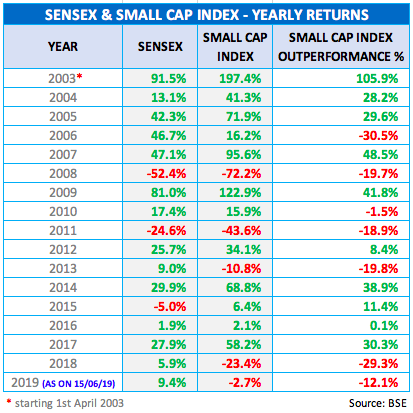Grow your Wealth by Investing in Hidden Gems Now!
Its a fact that 50 small and micro cap stocks out of 87 recommended by our team under Hidden Gems service during last 9 years have given more than 100% returns. Stocks like Cera Sanitaryware, Camlin Fine Sciences, Kovai Medical, Wim Plast, TCPL Packaging, Mayur Uniquoter, Roto Pumps etc are our multibagger stocks have given whopping returns in the range of 400% to 2000%.
Below are some of the Hidden Gems stocks released by us which turned out be multibaggers during last 9 years. Even after severe correction in small caps over last 1.5 years, as on date returns is in the range of 150% to 1800%. In fact, we already advised partial / full profit booking in many of these stocks at higher levels. The update of the same was published in our Hidden Gems Flash Back report.
HIDDEN GEMS STOCKS
|
RELEASE DATE
|
MULTIBAGGER
|
OLD REPORT
|
|---|---|---|---|
| 1. Camlin Fine Sciences |
27 Mar 2011
|
8-BAGGER
| |
| 2. Wim Plast |
30 Aug 2011
|
5-BAGGER
| |
| 3. Kovai Medical |
27 Oct 2011
|
7-BAGGER
| |
| 4. Cera Sanitaryware |
24 Dec 2011
|
19-BAGGER
| |
| 5. Mayur Uniquoter |
31 Mar 2012
|
5-BAGGER
| |
| 6. Roto Pumps |
05 Aug 2012
|
7-BAGGER
| |
| 7. Acrysil |
25 Nov 2012
|
5-BAGGER
| |
| 8. TCPL Packaging |
31 Mar 2013
|
5-BAGGER
| |
| 9. Rane Brake Lining |
31 May 2014
|
3-BAGGER
| |
| 10. Dynemic Products |
29 Jul 2014
|
2.5-BAGGER
| |
| 11. Mold-Tek Packaging |
22 Mar 2015
|
2.5-BAGGER
| |
| 12. Visaka Industries |
05 Jul 2015
|
3-BAGGER
| |
| 13. Chemfab Alkalies |
06 Sep 2015
|
2.5-BAGGER
| |
| 14. Ultramarine Pi. |
11 Oct 2015
|
2.5-BAGGER
| |
| 15. Stylam Industries |
08 May 2016
|
3-BAGGER
|
Post election outcome, Sensex & Nifty made all time high and delivered positive returns of ~15% since Jan 2018 where as broader markets i.e. Small Cap and Mid Cap indices delivered negative returns of 29% and 20% respectively during the same period. Most of the liquidity in small & mid caps has dried up and found its way to large caps over last 1.5 years. At this juncture, large caps looks fairly valued or expensive in terms of valuations, however small & mid cap companies look attractive and can reward long term investors in big way. In fact, some of the worst times to get into the market turned out to be the best times for long term investors and same seems to be applicable now for small & mid caps.
Small Cap Index has not delivered negative returns for 2 consecutive years in past 16 years
Whenever, Small Cap Index delivered significantly high negative returns in a particular year during last 16 years, it has delivered double digit positive returns the very next year. The divergence between Sensex / Nifty and Small & Mid Cap Index will not last for long going forward considering valuations gap emerging between large caps in comparison to mid & small cap stocks.
Remember, in the long run, you do not make decent returns on your investments by following the herd i.e. when everyone is buying stocks; instead you get handsome returns on our investments by investing in stocks at significantly low prices as no one else is buying, and by selling to them when they come back in herd due to greed in future.
Be a disciplined investor who keep on investing in systematic way irrespective of market conditions and not an emotional investor who usually buy stocks during bull phase when stock prices are moving higher because of greed and sell them in panic during bear phase due to severe fall in stock prices, making mistake of buying high and selling low.

 Home
Home Saral Gyan Freebies
Saral Gyan Freebies Saral Gyan Services
Saral Gyan Services About Us
About Us Contact Us
Contact Us


























